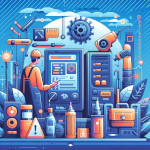
The world of build automation is constantly evolving, embracing new technologies and trends to further streamline the software development process. This concluding part explores these advancements and the exciting future that awaits build automation tools.
Cloud-Based Build Platforms: Scalability and Accessibility
Cloud-based build platforms are gaining significant traction. These platforms offer several advantages:
- Scalability: Cloud infrastructure provides on-demand resources, allowing builds to scale automatically based on project needs. This eliminates the need for developers to manage their own build servers.
- Accessibility: Cloud platforms enable developers to access build tools and environments from anywhere with an internet connection, fostering remote development and collaboration.
- Cost-Effectiveness: Cloud solutions often utilize a pay-as-you-go model, eliminating upfront infrastructure costs for development teams.
Integration with Artificial Intelligence (AI): Smarter Builds
The future of build automation is increasingly intertwined with Artificial Intelligence (AI). Here are some potential applications:
- Automated Testing: AI-powered tools can analyze code and automatically generate test cases, improving test coverage and efficiency.
- Build Optimization: AI algorithms can learn from historical data and suggest optimizations to build scripts, further reducing build times.
- Predictive Maintenance: AI can analyze build logs and identify potential issues before they occur, preventing build failures and delays.
The Rise of Containerization Technologies: Docker and Beyond
Containerization technologies like Docker are revolutionizing the way software is built and deployed. Build automation tools are integrating seamlessly with containerization workflows:
- Dockerfile Integration: Build tools can automate the creation of Dockerfiles, simplifying the process of building containerized applications.
- Multi-Container Builds: Tools can manage the building and deployment of complex applications composed of multiple interconnected containers.
- CI/CD Pipelines with Containers: Containerized build environments can ensure consistent build configurations across different development stages within CI/CD pipelines.
Conclusion: A Brighter Development Future
The future of build automation is brimming with possibilities. Cloud platforms offer scalability and accessibility, while AI promises smarter builds. The rise of containerization presents a new paradigm for building and deploying software. By embracing these advancements and leveraging the ever-expanding capabilities of build automation tools, developers can forge a brighter future for software development, one characterized by efficiency, consistency, and innovation.
This series has equipped you with a comprehensive understanding of build automation tools. From their core functionalities and language-specific applications to advanced concepts and the evolving landscape, you are now well-positioned to leverage these valuable tools to streamline your development workflow and build exceptional software.
